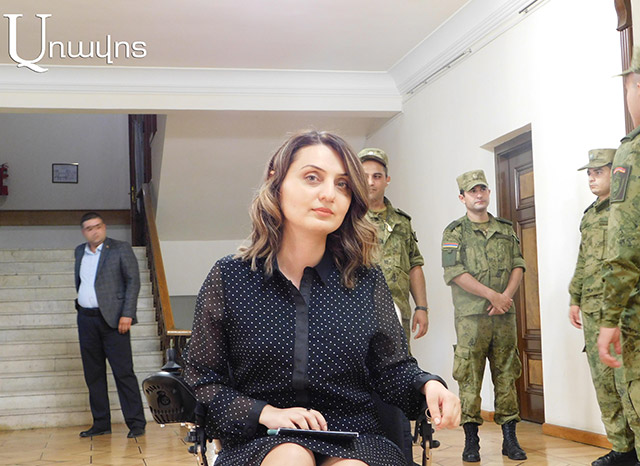
by Elodie Gavrilof
Last week, Mannig Georgelin published an article titled “How does one get around in a wheelchair in Armenia?”1GEORGELIN Mannig. “How does One Get Around in a Wheelchair in Armenia ?”. EVN Report. 2 octobre 2025. Link to the article about her experience navigating Yerevan as a young wheelchair user. Mannig doesn’t live in Armenia; she compares her two most recent visits, ten years apart, and shares her observations. To her pleasant surprise, she noticed a significant shift in how people perceive her.
The issue of disability has become even more relevant since 2020, taking on a new dimension. Armenian society’s perception of disability has evolved considerably in recent years, even though the country remains largely inaccessible to wheelchair users, especially outside central Yerevan. Although legislation has existed since the early 1990s, such as the 1993 Law on the Social Protection of Persons with Disabilities and the 2010 ratification of the UN Convention on the Rights of Persons with Disabilities (CRPD), the reality remains difficult. Much of the country is still inaccessible, and prejudice toward physical and mental disabilities continues to hinder inclusion. Some promising projects are underway, and the new public health insurance system, expected to take effect next year, will provide full coverage for disability-related medical care.
Figures like Zaruhi Batoyan, who became Minister of Labor and Social Affairs in 2019, have been pivotal in this shift. A wheelchair user herself, she helped bring greater visibility to people with disabilities in public life. She stepped down in November 2020 and was later elected to Parliament in 2021 for the Civil Contract party. As the 2016 recipient of the OSCE Prize for the Promotion of Inclusion, she remains deeply committed to disability rights.
However, as Mannig Georgelin notes, it was largely the war and its impact on countless families that gradually shifted public attitudes. Startups such as Armbionics and Oqni produce prosthetics for war-wounded individuals and accident victims. NGOs are also mobilising: Disability Rights Agenda (DRA), founded in 2021, advocates for inclusion and provides policy expertise and legal advice. Other initiatives, launched before the war, demonstrate that this movement is broader in scope: Therapists for Armenia, a U.S.-based NGO established in 2019, brings together therapists from various disciplines to promote accessibility and inclusion.
Disability Rights Agenda is fighting to ensure that the UN Convention is properly implemented in Armenia. In January 2025, Mushegh Hovsepyan, the NGO’s director and an inclusion expert, published a report based on a survey of people with disabilities. He noted that:
“While Armenia has made legislative progress, systemic issues persist. Disability assessment processes remain overly medicalized and lack transparency, excluding critical environmental factors. Persons with disabilities continue to face significant barriers in accessing education, employment, healthcare, and social protection, with marginalized groups disproportionately affected. Accessibility monitoring within public administration remains inadequate, and disaster preparedness efforts fail to account for the needs of persons with disabilities. Women, children, and refugees with disabilities face compounded exclusion and discrimination, further limiting their opportunities and rights.”2Disability Rights Agenda. Shadow Report : The implementation of the UN convention on the Rights of Persons with disabilities in Armenia”. 20 janvier 2025. (P. 7) Link to the report The NGO’s main criticism centers on how disability is assessed—both by authorities and by those affected. The algorithm used for these evaluations isn’t public, making the process opaque. DRA has filed legal action demanding its disclosure. While the courts ruled the algorithm illegal, they didn’t address the transparency issue. The NGO has appealed, and the case is still pending.
In recent years, public debate has also focused on the inclusion of children with disabilities in mainstream schools. Although a law was adopted as early as December 2014 to promote full inclusion by the 2025 school year, many stakeholders note that, while progress has been made, current resources remain insufficient3On this subject, see in particular: HARUTYUNYAN Anna. “Inclusive Education In Armenia”. The Armenian Weekly. 19 March 2024. Link to the article. Some schools do welcome students with disabilities, both public and private, such as Little Geniuses, located in central Yerevan. This institution, which educates children with autism, allows them to progress at their own pace. However, such establishments, often private, are costly, and many families cannot afford them. Moreover, these schools exist mainly in the capital, with few in the regions, deepening the educational gap between urban and rural areas. As in many other countries, the schooling of children with disabilities largely depends on public policies and the level of awareness among staff in national institutions.
These debates highlight how contemporary and pressing these issues are in Armenia. Geopolitical crises should not overshadow social concerns, which are crucial for organizations such as Armenia Peace Initiative (API), which conducts first aid training in border regions. Although we are not specialists in disability matters, we sincerely hope that progress will continue and are committed, at our level, to increasingly integrate these questions into our training programs.
